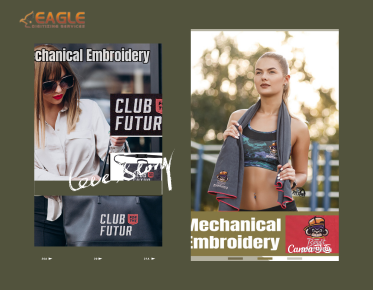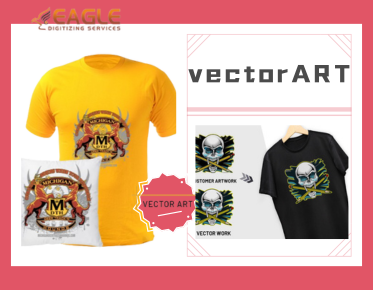Why Boost Gift Business Profits with Embroidery Digitizing & Vector Art
Why Boost Gift Business Profits with Embroidery Digitizing & Vector Art
In the competitive realm of gift businesses, visual appeal plays a pivotal role in attracting and retaining customers. The use of visually striking elements not only enhances product desirability but also establishes a unique brand identity. Embroidery digitizing and vector art represent two powerful tools in the modern gift industry's arsenal, offering unparalleled versatility and aesthetic refinement.
Embroidery digitizing involves the conversion of artwork into digital files that embroidery machines can interpret. This process ensures precision and consistency in stitching patterns, allowing for intricate designs that manual methods cannot replicate effectively.
The benefits of using digitized embroidery designs are manifold. They include enhanced efficiency in production, as digital files can be easily replicated and modified without loss of quality. Moreover, digitization allows for complex designs with multiple colors and detailed textures, elevating the overall visual appeal of embroidered products.
The impact of quality digitization on product appeal cannot be overstated. High-resolution digital files translate into crisp, clean embroidery that enhances the perceived value of gift items. This attention to detail can significantly influence purchasing decisions, especially in markets where craftsmanship and uniqueness are valued.
Exploring Vector Art in Gift Businesses
Vector art consists of scalable, mathematically defined shapes and lines that retain clarity regardless of size. In gift design, vector art offers distinct advantages over raster images, which can lose quality when resized.
The applications of vector art in gift items are diverse and adaptable. From logo embroidery on apparel to intricate patterns on accessories, vector-based designs ensure sharpness and consistency across different mediums. This versatility makes vector art indispensable for creating branded merchandise that maintains visual integrity across various marketing channels.
Enhancing Product Customization with Digital Designs
Customization is a cornerstone of successful gift businesses, allowing customers to personalize their purchases for special occasions or personal preferences. Embroidery digitizing and vector art enable this customization by providing a platform for tailored designs that resonate with individual tastes.
By leveraging digital designs, gift businesses can offer a spectrum of customization options without compromising on quality or turnaround time. Whether it's monogramming initials on luxury items or integrating personalized graphics into promotional gifts, digital tools empower businesses to meet diverse customer demands effectively.
Cost Efficiency and Scalability Benefits
Cost considerations in gift production are critical for maintaining profitability without compromising quality. Digital designs streamline production processes by minimizing material wastage and reducing labor-intensive tasks associated with traditional methods.
The scalability advantages of digital designs are evident in their ability to be effortlessly replicated across different product lines and quantities. This scalability not only facilitates bulk orders but also supports agile manufacturing strategies that respond promptly to market demands.
A comprehensive ROI comparison between digital and traditional design methods reveals significant savings in production costs and operational efficiency. By embracing digital technologies, gift businesses can achieve higher profit margins while maintaining competitive pricing in dynamic market conditions.
Marketing Strategies with Enhanced Visuals
Visual marketing is paramount in capturing consumer attention and driving sales in the gift industry. Digital designs play a pivotal role in creating visually compelling content that resonates with target audiences across online platforms and physical retail environments.
By integrating digital designs into marketing strategies, gift businesses can enhance brand visibility and engagement. From social media campaigns featuring vibrant product visuals to interactive online catalogs showcasing customizable options, effective visual marketing strategies leverage digital assets to stimulate consumer interest and foster brand loyalty.
Tips for creating compelling visual content include optimizing images for different digital platforms, maintaining brand consistency in design elements, and incorporating storytelling techniques that evoke emotional connections with consumers. By prioritizing visual appeal in marketing efforts, gift businesses can cultivate a distinctive brand identity that resonates with their target market.
Tools and Technologies for Effective Design Management
The landscape of design management in gift businesses is evolving with advancements in software tools tailored for embroidery digitizing and vector art. These tools streamline the design process, offering intuitive interfaces and robust functionalities that facilitate seamless creation, editing, and storage of digital assets.
Best practices in managing vector art files encompass file organization protocols, version control mechanisms, and integration with cloud-based storage solutions for accessibility and data security. By adopting efficient design management systems, gift businesses can optimize workflow efficiency and enhance collaboration between design teams and production units.
Collaborating with Design Professionals
The expertise of professional digitizers and vector artists is invaluable in achieving superior design outcomes that align with brand aesthetics and customer expectations. Collaborating with skilled professionals ensures meticulous attention to detail, technical proficiency in digitization techniques, and adherence to industry standards for quality assurance.
Finding and selecting the right design collaborators involves evaluating portfolios, assessing project compatibility, and establishing clear communication channels. By forging strategic partnerships with experienced designers, gift businesses can leverage specialized expertise to elevate product offerings and differentiate themselves in the competitive marketplace.
Trends in Digital Design for Gift Businesses
The evolving landscape of digital design in the gift industry is shaped by emerging trends in embroidery digitizing techniques and vector art applications. Current trends emphasize innovation in design complexity, incorporation of sustainable materials, and integration of augmented reality experiences to enhance consumer engagement.
Emerging vector art styles explore minimalist aesthetics, geometric patterns, and abstract compositions that resonate with contemporary consumer preferences. These trends underscore the dynamic nature of digital design, prompting gift businesses to adapt and innovate to maintain relevance and appeal in ever-changing market environments.
Forecasting future directions in digital design for gifts anticipates advancements in AI-driven design automation, customizable digital templates, and cross-platform compatibility for seamless integration across online retail channels. By staying abreast of industry trends and technological advancements, gift businesses can proactively leverage digital design strategies to sustain profitability and drive future growth.
Overcoming Challenges in Digital Design Implementation
Despite the advantages of digital design technologies, gift businesses may encounter challenges such as initial investment costs, staff training requirements, and compatibility issues with existing production infrastructure. Strategies for overcoming these challenges include conducting thorough cost-benefit analyses, investing in employee upskilling programs, and collaborating with technology providers to customize solutions that align with business objectives.
By addressing these challenges proactively, gift businesses can mitigate risks associated with digital design implementation and optimize operational efficiencies. Case studies highlighting successful implementation strategies offer valuable insights and practical solutions for navigating potential obstacles in the adoption of digital design technologies.
Conclusion
In conclusion, the integration of embroidery digitizing and vector art into gift business operations offers multifaceted benefits that enhance profitability and competitive advantage. From enhancing product customization and scalability to facilitating effective marketing strategies and overcoming implementation challenges, digital design technologies empower gift businesses to innovate, differentiate, and thrive in a dynamic marketplace.
Looking ahead, the future of digital design holds promise for continued innovation and strategic adaptation to emerging trends, reinforcing its role as a cornerstone of sustained profitability and business success in the evolving gift industry landscape.


